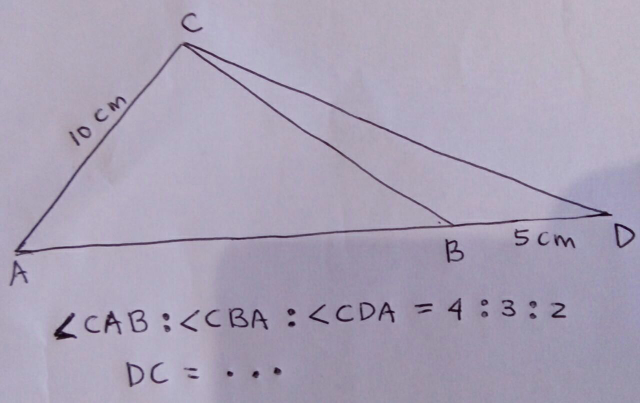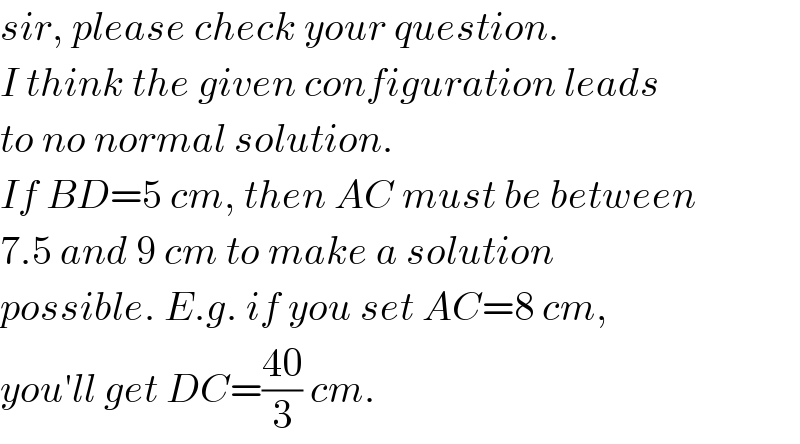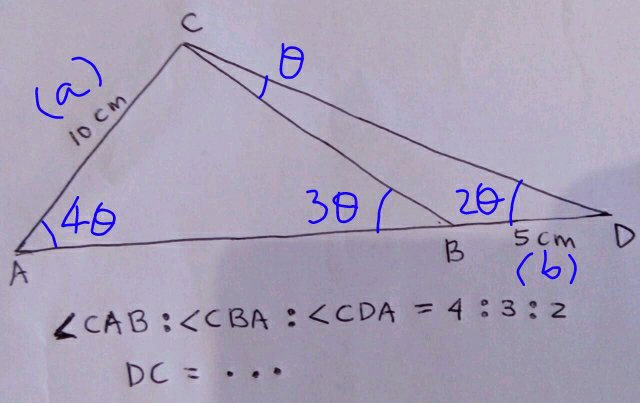Question Number 30159 by naka3546 last updated on 17/Feb/18

Commented by mrW2 last updated on 18/Feb/18

$${sir},\:{please}\:{check}\:{your}\:{question}. \\ $$$${I}\:{think}\:{the}\:{given}\:{configuration}\:{leads} \\ $$$${to}\:{no}\:{normal}\:{solution}. \\ $$$${If}\:{BD}=\mathrm{5}\:{cm},\:{then}\:{AC}\:{must}\:{be}\:{between} \\ $$$$\mathrm{7}.\mathrm{5}\:{and}\:\mathrm{9}\:{cm}\:{to}\:{make}\:{a}\:{solution} \\ $$$${possible}.\:{E}.{g}.\:{if}\:{you}\:{set}\:{AC}=\mathrm{8}\:{cm}, \\ $$$${you}'{ll}\:{get}\:{DC}=\frac{\mathrm{40}}{\mathrm{3}}\:{cm}. \\ $$
Answered by mrW2 last updated on 18/Feb/18

Commented by mrW2 last updated on 18/Feb/18

$${let}\:\lambda=\frac{{a}}{{b}} \\ $$$$\frac{{a}}{\mathrm{sin}\:\mathrm{3}\theta}=\frac{{CB}}{\mathrm{sin}\:\mathrm{4}\theta}\:\:\:…\left({i}\right) \\ $$$$\frac{{b}}{\mathrm{sin}\:\theta}=\frac{{CB}}{\mathrm{sin}\:\mathrm{2}\theta}\:\:\:…\left({ii}\right) \\ $$$$\left({i}\right)/\left({ii}\right): \\ $$$$\frac{{a}}{\mathrm{sin}\:\mathrm{3}\theta}×\frac{\mathrm{sin}\:\theta}{{b}}=\frac{\mathrm{sin}\:\mathrm{2}\theta}{\mathrm{sin}\:\mathrm{4}\theta}=\frac{\mathrm{1}}{\mathrm{2}\:\mathrm{cos}\:\mathrm{2}\theta} \\ $$$$\Rightarrow\frac{\lambda\:\mathrm{sin}\:\theta}{\mathrm{sin}\:\mathrm{3}\theta}=\frac{\mathrm{1}}{\mathrm{2}\:\mathrm{cos}\:\mathrm{2}\theta} \\ $$$$\mathrm{2}\lambda\:\mathrm{sin}\:\theta\:\mathrm{cos}\:\mathrm{2}\theta=\mathrm{sin}\:\mathrm{3}\theta=\mathrm{sin}\:\theta\:\mathrm{cos}\:\mathrm{2}\theta+\mathrm{cos}\:\theta\:\mathrm{sin}\:\mathrm{2}\theta \\ $$$$\left(\mathrm{2}\lambda−\mathrm{1}\right)\:\mathrm{sin}\:\theta\:\mathrm{cos}\:\mathrm{2}\theta=\mathrm{cos}\:\theta\:\mathrm{sin}\:\mathrm{2}\theta \\ $$$$\left(\mathrm{2}\lambda−\mathrm{1}\right)\:\mathrm{tan}\:\theta=\mathrm{tan}\:\mathrm{2}\theta=\frac{\mathrm{2}\:\mathrm{tan}\:\theta}{\mathrm{1}−\mathrm{tan}^{\mathrm{2}} \:\theta} \\ $$$$\mathrm{2}\lambda−\mathrm{1}=\frac{\mathrm{2}}{\mathrm{1}−\mathrm{tan}^{\mathrm{2}} \:\theta} \\ $$$$\mathrm{tan}^{\mathrm{2}} \:\theta=\mathrm{1}−\frac{\mathrm{2}}{\mathrm{2}\lambda−\mathrm{1}}>\mathrm{0}\:\Rightarrow\lambda>\frac{\mathrm{3}}{\mathrm{2}} \\ $$$$\Rightarrow\mathrm{tan}\:\theta=\sqrt{\mathrm{1}−\frac{\mathrm{2}}{\mathrm{2}\lambda−\mathrm{1}}} \\ $$$$\mathrm{3}\theta+\mathrm{4}\theta<\mathrm{180}° \\ $$$$\Rightarrow\theta<\frac{\mathrm{180}°}{\mathrm{7}}\approx\mathrm{2} \\ $$$$\mathrm{tan}^{\mathrm{2}} \:\theta=\mathrm{1}−\frac{\mathrm{2}}{\mathrm{2}\lambda−\mathrm{1}}<\mathrm{tan}^{\mathrm{2}} \:\left(\frac{\mathrm{180}°}{\mathrm{7}}\right) \\ $$$$\Rightarrow\lambda<\frac{\mathrm{1}}{\mathrm{2}}+\frac{\mathrm{1}}{\mathrm{1}−\mathrm{tan}^{\mathrm{2}} \:\frac{\mathrm{180}°}{\mathrm{7}}}=\mathrm{1}.\mathrm{8} \\ $$$${i}.{e}.\:{to}\:{make}\:{a}\:{solution}\:{possible}, \\ $$$$\mathrm{1}.\mathrm{5}<\lambda=\frac{{a}}{{b}}<\mathrm{1}.\mathrm{8} \\ $$$${for}\:{b}=\mathrm{5}\:{cm}: \\ $$$${a}>\mathrm{1}.\mathrm{5}×\mathrm{5}=\mathrm{7}.\mathrm{5}\:{cm} \\ $$$${a}<\mathrm{1}.\mathrm{8}×\mathrm{5}=\mathrm{9}\:{cm} \\ $$$$ \\ $$$${let}'{s}\:{say}\:{b}=\mathrm{8}\:{cm},\:\Rightarrow\lambda=\frac{\mathrm{8}}{\mathrm{5}}=\mathrm{1}.\mathrm{6} \\ $$$$\Rightarrow\mathrm{tan}\:\theta=\sqrt{\mathrm{1}−\frac{\mathrm{2}}{\mathrm{2}×\mathrm{1}.\mathrm{6}−\mathrm{1}}}=\frac{\mathrm{1}}{\:\sqrt{\mathrm{11}}}\:\Rightarrow\theta=\mathrm{16}.\mathrm{8}° \\ $$$$\Rightarrow\mathrm{cos}\:\mathrm{2}\theta=\mathrm{2}\:\mathrm{cos}^{\mathrm{2}} \:\theta−\mathrm{1}=\frac{\mathrm{2}}{\mathrm{1}+\mathrm{tan}^{\mathrm{2}} \:\theta}−\mathrm{1} \\ $$$$\Rightarrow\mathrm{cos}\:\mathrm{2}\theta=\frac{\mathrm{2}}{\mathrm{1}+\frac{\mathrm{1}}{\mathrm{11}}}−\mathrm{1}=\frac{\mathrm{2}×\mathrm{11}}{\mathrm{12}}−\mathrm{1}=\frac{\mathrm{5}}{\mathrm{6}} \\ $$$$\frac{{DC}}{\mathrm{sin}\:\mathrm{4}\theta}=\frac{{a}}{\mathrm{sin}\:\mathrm{2}\theta} \\ $$$$\Rightarrow{DC}=\frac{{a}\:\mathrm{sin}\:\mathrm{4}\theta}{\mathrm{sin}\:\mathrm{2}\theta}=\mathrm{2}{a}\:\mathrm{cos}\:\mathrm{2}\theta=\mathrm{2}×\mathrm{8}×\frac{\mathrm{5}}{\mathrm{6}}=\frac{\mathrm{40}}{\mathrm{3}} \\ $$
